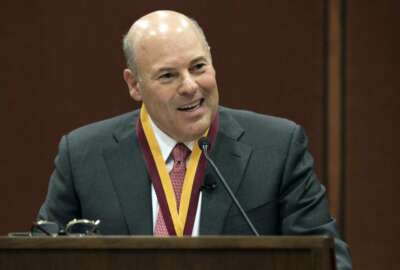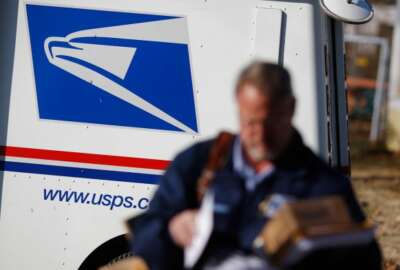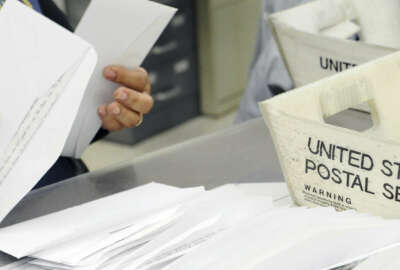

The Postal Service on Friday estimated that a $10 billion loan guaranteed under the CARES Act would give the agency enough cash to operate through May 2021. That...
The Postal Service on Friday estimated that a $10 billion loan guaranteed under the CARES Act would give the agency enough cash to operate through May 2021.
That loan buys the agency more time to work with Congress on a long-term legislative fix to its struggling business model. The House, meanwhile, already passed a significant piece of that legislative puzzle.
But the clock is ticking. The Postal Service continues to negotiate with the Treasury Department over reform conditions for the loan, and Congress remains divided on adding stopgap funding for the Postal Service in the next round of coronavirus spending.
While the coronavirus pandemic didn’t cause a drop in mail volume until late in the second quarter, the Postal Service still reported a $4.5 billion loss, more than twice what it lost in the same period last year.
Meanwhile, the Postal Service saw a 2% increase in total revenue compared to the same period from last year. First-class mail revenue, the driving force behind the agency’s current business model, increased by 1.4% because of mailing from the 2020 census.
Its shipping and package revenue grew 7% because of price increases that went into effect in January, as well as a “temporary surge in e-commerce” in late March that coincided with the coronavirus pandemic.
Despite the recent increase in its package business, the Postal Service doesn’t expect that boost will help offset a decline in mail volume that’s expected to worsen in the months and years to come because of the coronavirus pandemic.
“While the future is uncertain, we believe that the nation’s increased use of e-commerce is likely to plateau in the short term as the effects of the pandemic begin to subside, followed by a longer-term regression of e-commerce caused by a weakened U.S. economy,” the agency wrote in its quarterly financial report.
Meanwhile, an overall slump in the economy has led to an increase in retirement benefit expenses, which have long been a stumbling block for the agency’s financial health for more than a decade.
Postmaster General Megan Brennan told members of the House Oversight and Reform Committee last month that USPS expects a $13 billion revenue loss tied “directly to COVID-19” this fiscal year and a $54 billion hit over the next decade.
“The stark reality is that the pandemic will cause meaningful near term and long term implications from the steep decline in revenue. We will suffer this year and in the coming years,” Brennan told the USPS Board of Governors on Friday.
But USPS Chief Financial Officer Joe Corbett said the full scope of the pandemic’s effect on its operations has been hard to assess, since there are “more unknowns than knowns.”
The pandemic’s impact on the Postal Service’s bottom line will become more apparent at the end of this month when it releases the financial results for April.
“We are unable to predict the ultimate spread of the disease, the duration of COVID-19 business closures, the depth and duration of the recession we are certainly in right now, and the likelihood that the disease may recur,” Corbett said. “These facts make predicting the impact of that pandemic on our business extremely difficult.”
National Association of Letter Carrier President Fredric Rolando said Friday’s financial results demonstrate why temporary financial assistance for the Postal Service is “urgently needed” to keep operating.
“Just like the airlines and hotels and small businesses, the USPS, which also operates on earned revenue, needs assistance in these unprecedented times,” Rolando said in a statement.
NALC said more than 2,000 postal employees have contracted the coronavirus and 54 of them have died.
Meanwhile, a new postmaster general will soon lead the agency amid this tough financial situation.
The board has selected supply-chain and distribution center executive Louis DeJoy to serve as the next postmaster general, starting June 15.
As the chairman and CEO of New Breed Logistics, DeJoy will be the first postmaster general in more than 20 years to lead USPS without prior experience working there.
However, members of the board said DeJoy’s experience as a major logistics contractor for the Postal Service for more than 25 years makes him an asset for the agency.
“He understands the critical public service function of the institution, and he’s committed to working with all of our stakeholders on preserving and strengthening the postal service for the future,” board chairman Robert Duncan said.
Paul Steidler, a senior fellow with the Lexington Institute, told Federal News Network that DeJoy’s background makes him a likely candidate to tackle “more arcane” issues that drive the Postal Service’s delivery network.
“He is someone who knows how to use technology to get better results out of things. He’s someone who knows how to squeeze operational costs and find ways to do things more efficiently. Given that the Postal Service is a $70 billion a year or so entity … there are a number of opportunities for doing things more efficiently and cutting costs,” Steidler said.
Copyright © 2025 Federal News Network. All rights reserved. This website is not intended for users located within the European Economic Area.
Jory Heckman is a reporter at Federal News Network covering U.S. Postal Service, IRS, big data and technology issues.
Follow @jheckmanWFED



